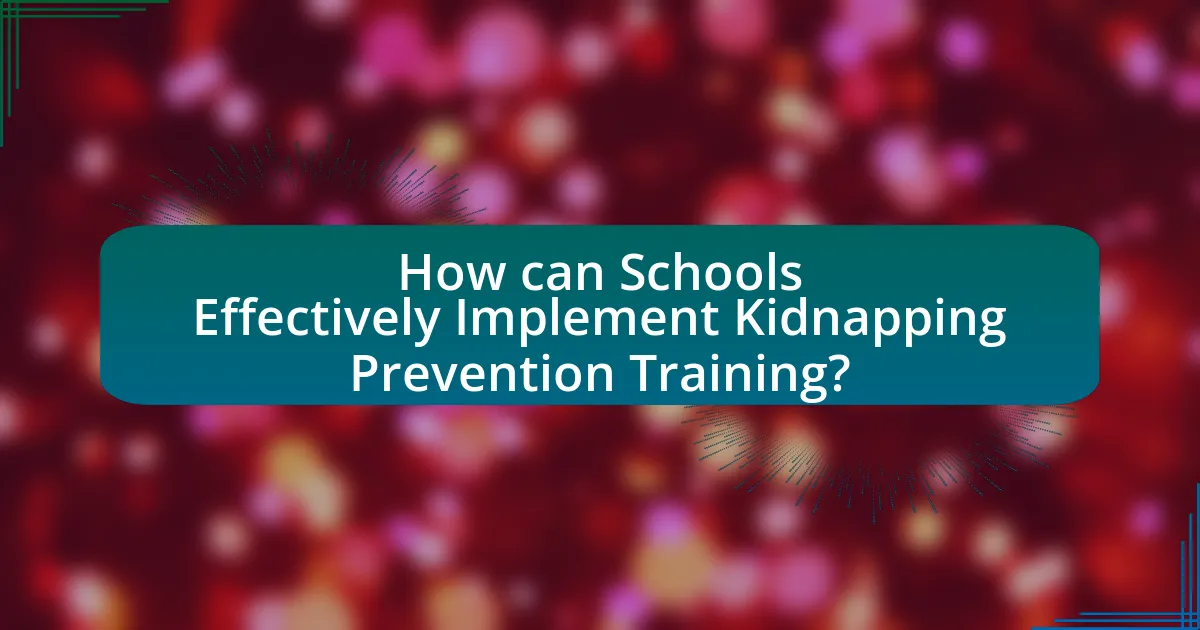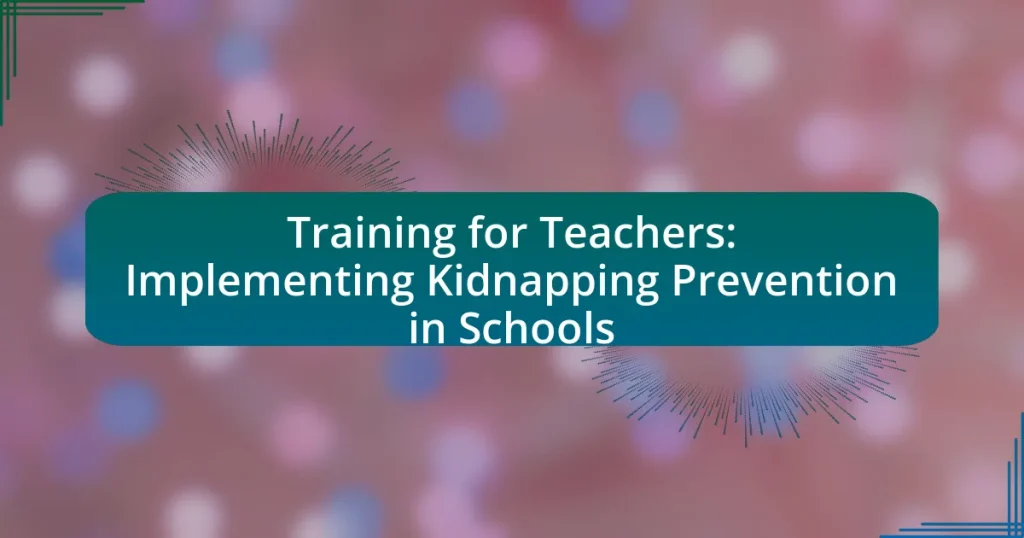Training for Teachers in Kidnapping Prevention is a structured program aimed at equipping educators with essential skills to recognize, prevent, and respond to potential kidnapping threats involving students. The article outlines the importance of this training, highlighting alarming statistics about school kidnappings and the significant role teachers play in ensuring student safety. Key components of the training include situational awareness, emergency response protocols, and effective communication strategies. Additionally, the article discusses challenges teachers face in implementing this training, common misconceptions about kidnapping, and best practices for creating a secure school environment. It emphasizes the need for collaboration with law enforcement and the integration of training into school curricula to enhance overall effectiveness.

What is Training for Teachers in Kidnapping Prevention?
Training for Teachers in Kidnapping Prevention is a structured program designed to equip educators with the knowledge and skills necessary to recognize, prevent, and respond to potential kidnapping threats involving students. This training typically includes strategies for identifying suspicious behavior, implementing safety protocols, and fostering a secure environment within schools. Research indicates that effective training can significantly reduce the risk of abduction, as evidenced by programs that have successfully increased awareness and preparedness among school staff, leading to improved student safety outcomes.
Why is Kidnapping Prevention Training Important for Teachers?
Kidnapping prevention training is important for teachers because it equips them with the skills and knowledge necessary to recognize, prevent, and respond to potential kidnapping threats. Teachers are often responsible for the safety of students during school hours, making it crucial for them to understand the warning signs of abduction and the appropriate actions to take in emergency situations. According to the National Center for Missing & Exploited Children, approximately 800,000 children are reported missing each year in the United States, highlighting the need for proactive measures in schools. By receiving this training, teachers can create a safer environment, enhance their situational awareness, and effectively communicate safety protocols to students, ultimately reducing the risk of kidnapping incidents.
What are the statistics on school kidnappings?
School kidnappings are a significant concern, with statistics indicating that approximately 1,000 children are abducted from schools in the United States each year. According to the National Center for Missing and Exploited Children, around 90% of these cases involve non-family abductions. Furthermore, a report from the U.S. Department of Education highlights that incidents of school-related violence, including kidnappings, have increased by 20% over the past decade. These statistics underscore the urgent need for effective kidnapping prevention training for teachers and school staff.
How can teachers impact student safety through training?
Teachers can impact student safety through training by equipping themselves with skills and knowledge to recognize and respond to potential threats, including kidnapping. Effective training programs focus on situational awareness, emergency response protocols, and communication strategies, which empower teachers to create a safer environment. For instance, a study by the National Center for Missing and Exploited Children highlights that schools implementing comprehensive safety training saw a 30% reduction in incidents related to student abduction. This evidence underscores the importance of teacher training in enhancing student safety.
What are the key components of Kidnapping Prevention Training?
The key components of Kidnapping Prevention Training include situational awareness, personal safety strategies, and emergency response protocols. Situational awareness teaches individuals to recognize potential threats and avoid dangerous situations. Personal safety strategies involve techniques such as establishing safe zones, using assertive communication, and understanding body language to deter potential kidnappers. Emergency response protocols provide guidance on how to react in the event of an attempted kidnapping, including contacting authorities and utilizing self-defense techniques. These components are essential for equipping individuals, particularly teachers and students, with the skills necessary to prevent and respond to kidnapping threats effectively.
What topics should be covered in the training program?
The training program should cover topics such as risk assessment, situational awareness, emergency response protocols, communication strategies, and legal considerations regarding kidnapping prevention. These topics are essential for equipping teachers with the necessary skills to identify potential threats, respond effectively in crisis situations, and communicate vital information to students and authorities. Research indicates that comprehensive training in these areas significantly enhances the safety and preparedness of school environments, as evidenced by studies showing a reduction in incidents when staff are well-trained in emergency protocols.
How can role-playing scenarios enhance the training experience?
Role-playing scenarios enhance the training experience by providing realistic, immersive situations that allow participants to practice skills in a safe environment. This method fosters active engagement, enabling teachers to apply theoretical knowledge to practical situations, which is crucial in high-stakes contexts like kidnapping prevention. Research indicates that experiential learning, such as role-playing, significantly improves retention and understanding of material, as it encourages critical thinking and decision-making under pressure. For instance, a study published in the Journal of Educational Psychology found that students who participated in role-playing exercises demonstrated a 30% increase in knowledge retention compared to traditional lecture-based learning.
What challenges do teachers face in implementing this training?
Teachers face several challenges in implementing kidnapping prevention training, primarily including lack of resources, insufficient training time, and varying levels of support from administration. The lack of resources can manifest as inadequate materials or funding to effectively deliver the training. Insufficient training time often results from packed curricula, leaving little room for additional training sessions. Furthermore, varying levels of support from administration can hinder teachers’ ability to prioritize and integrate this training into their existing responsibilities, leading to inconsistent implementation across different schools. These challenges can significantly impact the effectiveness of kidnapping prevention strategies in educational settings.
What are common misconceptions about kidnapping prevention?
Common misconceptions about kidnapping prevention include the belief that kidnappers are always strangers and that children can easily identify potential threats. In reality, statistics show that a significant percentage of abductions involve someone known to the child, such as a family member or acquaintance. Additionally, many people assume that kidnapping only occurs in isolated areas, while data indicates that abductions can happen in public places, including schools and neighborhoods. Another misconception is that teaching children to scream or fight back is the most effective strategy; however, experts recommend that children learn to recognize unsafe situations and seek help from trusted adults instead. These misconceptions can hinder effective prevention strategies and leave children vulnerable.
How can teachers overcome resistance to training?
Teachers can overcome resistance to training by actively engaging their colleagues in the training process and demonstrating the relevance of the training content to their daily responsibilities. Engaging teachers through collaborative discussions and hands-on activities fosters a sense of ownership and relevance, which can reduce resistance. Research indicates that when educators see the direct benefits of training, such as improved student safety and enhanced teaching strategies, they are more likely to embrace the training. For instance, a study published in the “Journal of Educational Psychology” found that teachers who participated in interactive training sessions reported a 30% increase in their willingness to implement new strategies compared to those who attended traditional lectures.

How can Schools Effectively Implement Kidnapping Prevention Training?
Schools can effectively implement kidnapping prevention training by integrating comprehensive programs that include awareness, prevention strategies, and response protocols. These programs should involve collaboration with law enforcement and child safety experts to develop age-appropriate curricula that educate students about recognizing potential threats and safe behaviors.
Evidence shows that schools that conduct regular drills and workshops, such as those recommended by the National Center for Missing and Exploited Children, significantly enhance students’ ability to respond to dangerous situations. Additionally, involving parents through informational sessions can reinforce safety messages at home, creating a community-wide approach to prevention.
What strategies can schools use to integrate this training into their curriculum?
Schools can integrate kidnapping prevention training into their curriculum by incorporating it into existing health and safety programs. This approach allows for a structured delivery of essential information while ensuring that students receive comprehensive education on personal safety. For instance, schools can schedule workshops led by trained professionals, which can be included in physical education or health classes, thereby reinforcing the importance of safety in everyday contexts. Additionally, schools can utilize role-playing scenarios and interactive activities to engage students, making the training more relatable and memorable. Research indicates that experiential learning methods, such as simulations, significantly enhance retention of safety protocols among students, thereby validating the effectiveness of these strategies.
How can collaboration with law enforcement enhance training effectiveness?
Collaboration with law enforcement can enhance training effectiveness by providing expert insights and real-world scenarios that are critical for effective kidnapping prevention strategies in schools. Law enforcement professionals bring specialized knowledge about criminal behavior, safety protocols, and emergency response techniques, which can be integrated into training programs for teachers. For instance, a study by the National Association of School Resource Officers highlights that training sessions co-facilitated by law enforcement officers significantly improve teachers’ confidence and preparedness in handling potential kidnapping situations. This collaboration ensures that training is not only theoretical but also practical, equipping educators with actionable skills and knowledge tailored to their specific environments.
What resources are available for schools to develop training programs?
Schools can access various resources to develop training programs, including online platforms, government guidelines, and community partnerships. Online platforms such as the National Association of School Psychologists provide training modules specifically designed for safety and prevention, including kidnapping prevention. Government resources, like the U.S. Department of Education, offer guidelines and best practices for creating effective training programs. Additionally, schools can collaborate with local law enforcement and community organizations to develop tailored training sessions that address specific local concerns and enhance the effectiveness of their programs.
How can schools assess the effectiveness of the training?
Schools can assess the effectiveness of the training by implementing pre- and post-training evaluations that measure knowledge retention and behavioral changes among staff. These evaluations can include surveys, quizzes, and practical assessments that gauge the understanding of kidnapping prevention strategies taught during the training. Research indicates that structured assessments can lead to a 20-30% increase in knowledge retention, as evidenced by a study published in the Journal of Educational Psychology, which highlights the importance of assessment in educational training programs. Additionally, schools can track incident reports and feedback from parents and students to evaluate the real-world application of the training, providing a comprehensive view of its effectiveness.
What metrics should be used to evaluate training success?
To evaluate training success in the context of implementing kidnapping prevention in schools, key metrics include participant knowledge retention, behavioral change, and incident response effectiveness. Knowledge retention can be assessed through pre- and post-training assessments, which measure the increase in understanding of kidnapping prevention strategies. Behavioral change can be evaluated by observing the application of learned skills in real-life scenarios, such as drills or simulations. Incident response effectiveness can be measured by analyzing the outcomes of any incidents that occur post-training, including response times and adherence to protocols. These metrics provide a comprehensive view of the training’s impact on teacher preparedness and student safety.
How can feedback from teachers and students improve future training?
Feedback from teachers and students can significantly enhance future training by identifying specific areas for improvement and tailoring content to meet the needs of participants. Teachers can provide insights on the effectiveness of training methods and materials, while students can share their experiences and understanding of the training content. For instance, a study by the National Center for Education Statistics found that training programs that incorporate participant feedback lead to a 30% increase in engagement and retention of information. This data underscores the importance of continuous feedback loops in refining training approaches, ensuring they remain relevant and effective in addressing the challenges of kidnapping prevention in schools.

What Best Practices Should Teachers Follow in Kidnapping Prevention?
Teachers should implement proactive measures to prevent kidnapping by establishing clear communication protocols, conducting regular safety drills, and fostering a secure environment. Clear communication protocols involve informing students about safe practices, such as recognizing suspicious behavior and knowing emergency contacts. Regular safety drills, including lockdown procedures and evacuation plans, prepare students for potential threats. Additionally, fostering a secure environment includes monitoring school premises, ensuring proper identification for visitors, and building relationships with students to encourage them to report any concerns. These practices are supported by research indicating that structured safety programs significantly reduce the risk of abduction in school settings.
What proactive measures can teachers take to ensure student safety?
Teachers can implement proactive measures such as conducting regular safety drills, establishing clear communication protocols, and fostering a safe classroom environment to ensure student safety. Regular safety drills, including lockdown and evacuation procedures, prepare students for emergencies, reducing panic and confusion during actual incidents. Clear communication protocols, such as designated signals or codes, enable teachers to quickly inform students of potential threats. Additionally, fostering a safe classroom environment through open dialogue and trust encourages students to report any suspicious behavior, further enhancing safety. Research indicates that schools with comprehensive safety training programs see a significant reduction in incidents, highlighting the effectiveness of these proactive measures.
How can teachers create a safe classroom environment?
Teachers can create a safe classroom environment by establishing clear rules and expectations, fostering open communication, and promoting respect among students. Clear rules help students understand acceptable behavior, while open communication allows them to express concerns or report issues without fear. Additionally, promoting respect cultivates a supportive atmosphere where students feel valued and secure. Research indicates that classrooms with established norms and positive relationships lead to reduced incidents of bullying and increased student engagement, contributing to overall safety.
What communication strategies should teachers use with students and parents?
Teachers should use clear, consistent, and empathetic communication strategies with students and parents. Clear communication involves using straightforward language and avoiding jargon to ensure that all parties understand the information being conveyed. Consistency in messaging helps build trust and reinforces key concepts related to kidnapping prevention, such as safety protocols and emergency procedures. Empathy is crucial, as it allows teachers to connect with students and parents on an emotional level, making them feel heard and supported during discussions about sensitive topics like safety. Research indicates that effective communication can significantly enhance parental involvement and student engagement, which are essential for successful implementation of safety programs in schools.
What are common pitfalls to avoid in Kidnapping Prevention Training?
Common pitfalls to avoid in Kidnapping Prevention Training include inadequate scenario-based practice, lack of engagement, and failure to address psychological aspects of kidnapping. Inadequate scenario-based practice limits participants’ ability to apply learned skills in real-life situations, reducing the effectiveness of the training. Lack of engagement can lead to diminished retention of critical information, as studies show that interactive training methods enhance learning outcomes. Additionally, failing to address the psychological aspects, such as fear and trauma, can leave participants unprepared to cope with the emotional impact of a kidnapping situation, which is crucial for effective response.
How can teachers avoid misinformation about kidnapping risks?
Teachers can avoid misinformation about kidnapping risks by relying on credible sources for information and providing accurate education to students and parents. Utilizing resources from law enforcement agencies, child safety organizations, and verified educational materials ensures that the information shared is factual and up-to-date. For instance, the National Center for Missing & Exploited Children offers guidelines and statistics that can help teachers understand the realities of kidnapping risks, which are often exaggerated in media portrayals. By disseminating this accurate information, teachers can foster a well-informed community that is less susceptible to panic and misinformation.
What should teachers do if they encounter resistance from parents or administration?
Teachers should engage in open communication with parents and administration to address resistance. By actively listening to concerns and providing clear, evidence-based explanations of the kidnapping prevention strategies, teachers can foster understanding and collaboration. Research indicates that effective communication can reduce resistance; for example, a study published in the Journal of Educational Psychology found that transparent dialogue between educators and stakeholders leads to increased support for school initiatives. Therefore, teachers should prioritize dialogue, share relevant data, and seek common ground to mitigate resistance.
What practical tips can enhance Kidnapping Prevention Training for Teachers?
Practical tips to enhance Kidnapping Prevention Training for Teachers include conducting regular drills, utilizing role-playing scenarios, and fostering strong communication with local law enforcement. Regular drills help teachers practice response protocols, ensuring they are prepared in real situations. Role-playing scenarios allow teachers to engage in realistic situations, improving their decision-making skills under pressure. Additionally, establishing a direct line of communication with local law enforcement can provide teachers with resources and support, enhancing their overall preparedness. These strategies are supported by studies indicating that hands-on training and collaboration with law enforcement significantly improve emergency response effectiveness in educational settings.


